Whether exploring vibrant coral reefs in the Maldives, encountering intricate marine life in the Red Sea, or navigating the quiet depths of historic shipwrecks in the Caribbean, underwater adventures reveal an extraordinary side of the natural world. For water loving travellers, the ocean offers more than just a sunny escape — it’s a chance to discover an entirely different world.
From clownfish and moray eels to swaying anemones and brain corals, the underwater world is teeming with vibrant life. But when it comes to how you explore it, you’ve got options – and the first big choice is between snorkelling and scuba diving.
Each offers a unique window into life below the surface, and your decision will depend on what kind of experience you’re after – casual surface floating or full submersion into the blue.
So, which is better for you? In this guide, we’ll delve into the key differences, pros and cons, costs, safety considerations, and swimming ability. We’ll also explore a few exciting alternatives — like Snuba, free diving, and sea walking — that might just be the underwater fix you’re looking for.
What’s the difference between snorkelling and scuba diving?
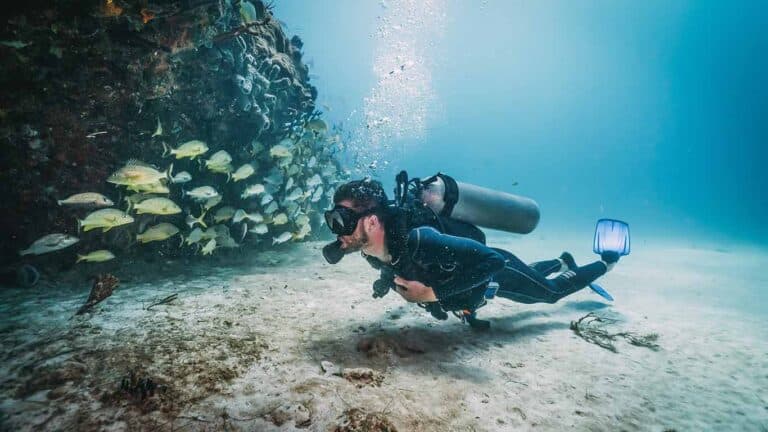
Both snorkelling and scuba diving let you experience the ocean’s wonders up close, but they do so in very different ways. You could say – snorkelling is like looking through a window, while scuba diving is like stepping through the door, but what’s actually involved?
Snorkelling
Snorkelling is all about ease and accessibility. You stay on the surface, breathing through a snorkel while looking down through your mask at the marine life below. It’s ideal for spotting colourful fish, coral reefs, sea grasses, and even rays or turtles if you’re lucky, all without diving deep.
Snorkelling suits shallow, calm waters where marine life is active near the surface. Reefs, lagoons, and rocky outcrops are prime spots.
Scuba Diving
Scuba diving takes things to the next level, literally. With a tank of compressed air on your back and a regulator to breathe through, you can explore much deeper underwater environments for longer periods.
This opens up a whole new realm of possibilities: dramatic drop-offs, coral walls, wrecks, underwater caves, and a chance to encounter bigger marine life – think reef sharks, barracudas, sea turtles, and schools of fish swirling around you.
Scuba allows you to go where snorkelling can’t, exploring deeper, longer, and into more complex and fascinating environments.
Key differences explained
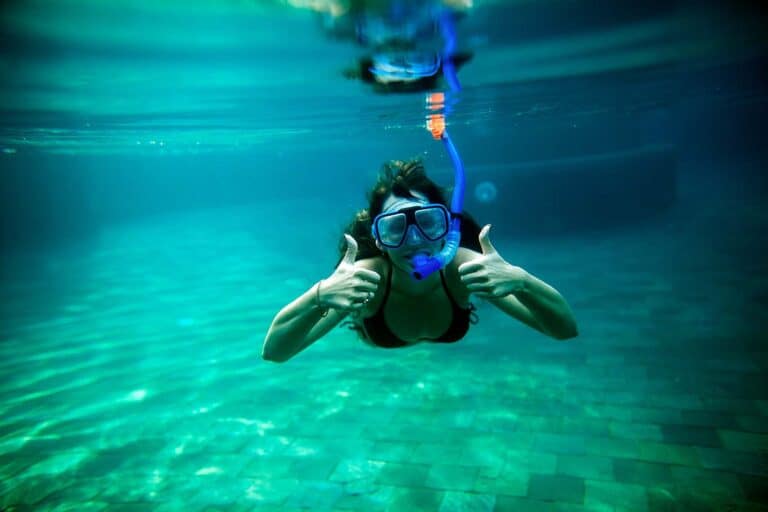
Breathing and air supply
Snorkellers breathe through a simple snorkel tube while floating at the surface. Your face is in the water, but your mouth stays connected to the air above, which makes it easy and low-pressure for beginners. You’ll need to be comfortable exhaling water if a wave splashes into your snorkel, but that’s about as technical as it gets.
Scuba divers on the other hand, breathe compressed air from a tank via a regulator. This allows you to stay fully submerged for 30 to 60 minutes at a time, depending on depth and air consumption. Breathing underwater feels strange at first but quickly becomes second nature with proper training.
Depth of water
Snorkelling is best done in shallow areas, typically 1 to 5 metres deep. It’s perfect for reef edges, lagoons, and coastal shallows where marine life is close to the surface.
Scuba diving allows you to explore much deeper areas. Beginner divers are certified to dive to 18 metres, while advanced or speciality divers can go down to 30–40 metres. This extra depth opens up access to wrecks, walls, deeper coral ecosystems, and larger marine species.
Equipment required
Snorkelling requires just the basics: a mask, snorkel, and fins. Optional extras include a floatation vest for confidence and a wetsuit in cooler waters.
Scuba diving involves more kit: a wetsuit, fins, mask, BCD (buoyancy control device), regulator, air tank, and often weights to help you descend. A dive computer or depth gauge is used to monitor depth and time to keep your dive within safe limits.
Most scuba gear can be hired, so there’s no need to buy everything up front, especially for beginners.
Training and certification
Snorkelling doesn’t require any formal training. If you’re comfortable in the water, you can start with just a short safety briefing. Guided snorkel tours are a great way to learn the basics while spotting fish with the help of a pro.
Scuba diving, by contrast, does require certification. The most common route is the PADI Open Water Diver course, which takes 3 to 4 days. It includes online or classroom theory, confined water practice (usually in a pool), and four open water dives to test your skills. Once qualified, you can dive independently (with a buddy) up to 18 metres.
Cost comparison
Snorkelling is budget friendly. You can often hire gear for £10–£15 or join a guided boat tour for around £20–£30. Some beach resorts even offer free snorkelling equipment for guests.
Scuba diving is a bigger investment. Certification courses start at £300–£500 in the UK, with dives abroad often cheaper (around £200–£300 in places like Egypt or Southeast Asia). Once qualified, fun dives typically cost £50–£100 each, including gear rental and boat transport.
What can you explore?
Snorkellers get a fantastic look at shallow marine life, vibrant corals, tropical fish, sea grasses, starfish, rays, and even the odd turtle. You’ll often snorkel over fringing reefs or in calm bays, where the action is visible just below the surface.
Scuba divers gain access to a far more varied underwater landscape: deep coral walls, sponge gardens, artificial reefs, and shipwrecks. You’ll also encounter more elusive or larger creatures, such as sharks, groupers, manta rays, and even octopuses or dolphins in the right place at the right time.
Risks
All water sports carry some level of risk but being aware and well-prepared makes a huge difference.
Snorkelling risks:
- Sunburn & dehydration: You’re on the surface, exposed to sun for long periods.
- Currents & tides: Can carry you away from shore if you’re not careful.
- Water inhalation: If you panic or are hit by waves, you could inhale water through the snorkel.
- Marine life: Stings or scrapes (e.g. jellyfish or sea urchins) are possible.
Scuba diving risks:
- Pressure-related injuries: Such as ear barotrauma if you don’t equalise properly.
- Decompression sickness (“the bends”): If you ascend too quickly or exceed safe dive limits.
- Running out of air: Rare with proper planning, but critical to monitor.
- Equipment failure: Minimise risk through checks and using reputable dive centres.
- Medical limitations: Asthma, heart issues, or ear problems can make diving unsafe, always get medical clearance if unsure.
Most risks can be mitigated with training, following safety procedures, and diving with a certified guide or buddy.
Safety
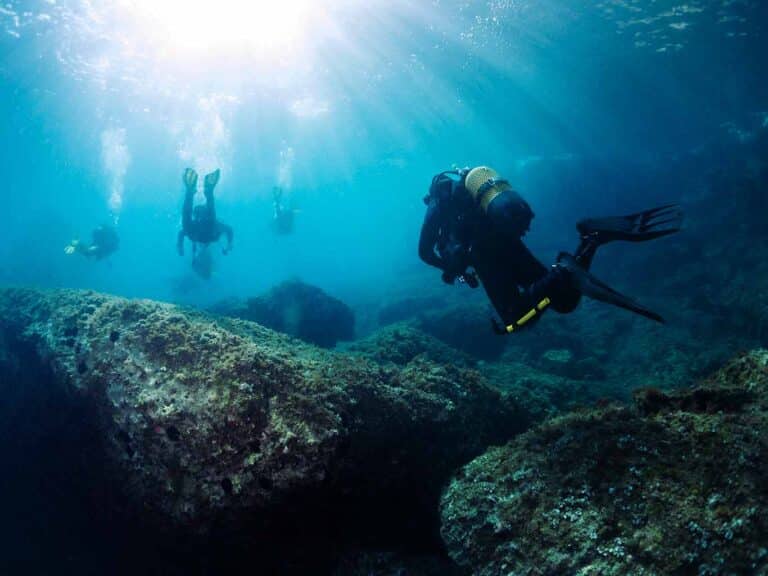
Snorkelling safety tips
- Always go with a buddy or group
- Wear a buoyancy vest if unsure in water
- Watch out for currents and boat traffic
Scuba diving safety tips
- Never dive alone
- Monitor your depth and air supply
- Equalise pressure frequently
- Always follow your dive plan and instructor
Do you need to be a strong swimmer?
Snorkelling: Basic swimming and floating is enough, especially with a vest.
Scuba diving: You should be comfortable in the water. Most dive courses require a swim test (e.g. 200 metres) and treading water for 10 minutes.
Other underwater activities to consider
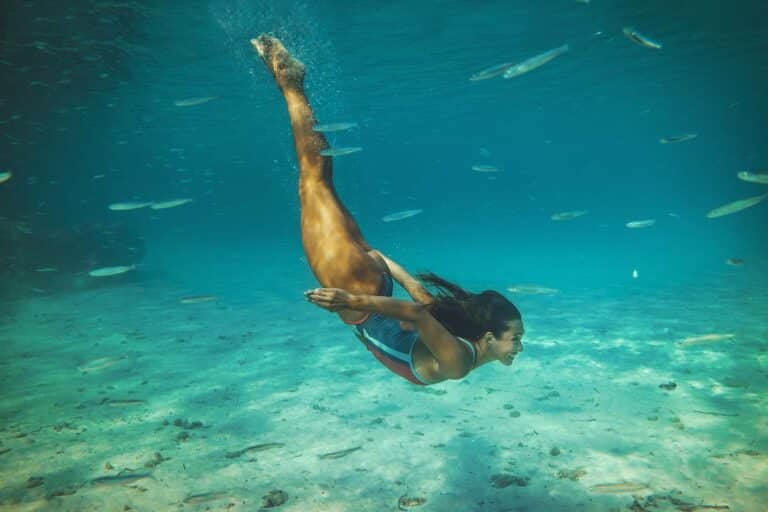
If scuba sounds a bit too intense and snorkelling feels too limited, here are a few other underwater options:
Snuba
A hybrid of snorkelling and scuba — you breathe through a regulator attached to an air hose that floats on a raft above you. No tank on your back!
- Depth: Around 6 metres
- Cost: £50–£80 per session
- Training: None needed
- Great for: Beginners who want a taste of diving without the full course
Free diving
Diving on a single breath — sounds mad, but it’s a real sport focused on breath control and mindfulness.
- Depth: Varies based on skill
- Cost: Courses from £200+
- Training: Definitely required!
- Risks: High if done unsafely (e.g. blackouts, pressure injuries)
Sea walking
Wearing a space-like helmet, you walk along the seabed on a guided underwater stroll.
- Depth: 3–5 metres
- Cost: £40–£70
- Swimming Required: Not essential
- Great for: Non-swimmers, older travellers, or anyone wanting an easy underwater fix
Comparison sum-up
| Activity | Training Needed | Cost | Depth | Equipment | Risk Level | Swim Skill |
| Snorkelling | No | Low | 1–5m | Light | Low | Basic |
| Scuba Diving | Yes | High | 10–30m | Full Gear | Medium | Good |
| Snuba | No | Medium | 6m | Air Hose | Low-Med | Basic |
| Free Diving | Yes | Medium | Varies | Minimal | High | Strong |
| Sea Walking | No | Medium | 3–5m | Helmet | Low | None |
Whether you’re exploring the Red Sea, the Great Barrier Reef, or the coast of Cornwall, there’s a whole world waiting beneath the surface. Whether you fancy dipping your toes in with snorkelling or taking the plunge with scuba, the key is to go at your own pace, stay safe, and respect the ocean.
How to start scuba diving
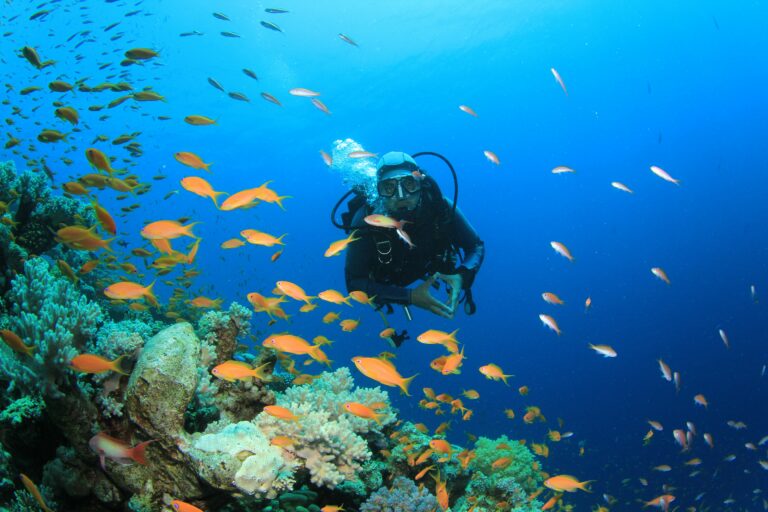
We’ve established that snorkelling is super accessible and easy for anyone to pick up but what about getting into scuba diving? You might wonder what the best routes into the sport are and how long it might take before you’re out in the water on your first dive.
Training
The most popular and recognised way to start scuba diving is by taking the PADI Open Water Diver course (or the equivalent from other agencies like SSI or BSAC).
This beginner-level certification qualifies you to dive up to 18 metres anywhere in the world with a buddy — no instructor needed after certification.
Most beginner scuba diving courses are broken into three parts:
Theory & knowledge development
Learn the basics of diving physics, safety, equipment, and underwater communication.
Can be done online (e-learning) or in a classroom.
Time: 6–8 hours, self-paced.
Confined water dives
Practise skills like breathing underwater, clearing your mask, and buoyancy control in a pool or calm shallow water.
Time: 1–2 days.
Open water dives
Your first proper dives! Usually 4 dives over 2 days, in the sea or a lake, under instructor supervision.
Time: 2 days.
How long until you’re in the water?
You can go from complete beginner to certified diver in 3 to 4 days with an intensive course or spread it out over a couple of weekends if you’re doing it locally in the UK. Many travellers choose to complete the theory in advance online, then finish their dives abroad in warmer waters.
How much does it cost?
In the UK: Around £350–£500 for the full PADI Open Water course, depending on the dive centre and location.
Abroad (e.g. Egypt, Thailand): You might pay as little as £200–£300, thanks to lower local costs, but check that the centre is reputable and certified.
You can also do a “referral” – complete your theory and pool sessions in the UK, then finish your open water dives on holiday.
Where to learn
Most PADI dive centres offer beginner taster sessions called Discover Scuba Diving, which let you try diving in a pool or shallow sea without committing to a full course — perfect for seeing if it’s for you.
A few final tips
- You don’t need to buy all the gear straight away. Most courses include equipment rental, and it’s best to try diving a few times before investing in your own mask, fins, wetsuit, etc.
- Get a fit-to-dive medical if you have any respiratory, heart, or ear issues.
- Book your course with a certified dive centre (look for PADI, SSI, or BSAC logos).
- Don’t rush, take your time getting comfortable in the water.
- Once certified, keep diving regularly to build your confidence and skill.
Find out more about where to scuba dive in Europe.
Next stop: the ocean. With a bit of training, you’ll be floating beside fish, corals, and maybe even a curious turtle or two – it’s a feeling like no other.
Get specialist scuba diving insurance with SportsCover Direct
When it comes to scuba diving and snorkelling, we’ve discussed a few risks to be aware of when you take to the water. While you’re pushing new limits and enjoying physically challenging adventures in far-flung locations, it makes sense to choose scuba diving travel insurance that offers protection against whatever may happen.
SportsCover Direct’s Scuba Diving Travel Insurance will let you breathe easily as you take off on your next expedition. We’ve designed a range of worldwide cover options to provide reassurance and protection for divers of all experience levels. With options such as cover for pre-existing medical conditions, emergency medical treatment and diving depths of 40 metres and more, you can choose from single-trip or multi-trip policies. You can also cover yourself against any changes or cancellations to your trip.
Read more about our Scuba Diving Travel Insurance and request a quote that meets your needs. Our experienced and professional team will be available to chat should you have any questions at all.
This blog has been created as general information and should not be taken as advice. Make sure you have the correct level of insurance for your requirements and always review policy documentation.